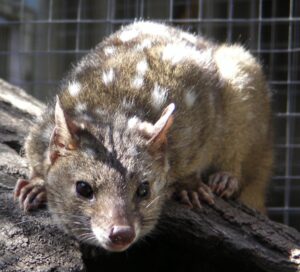Australia Offers a New Hope for a Threatened Species: Western Quolls Live Well
In Australia, ecologists are celebrating the success of their efforts to save a species from extinction, and a stunning tale of optimism has emerged. A recent remarkable finding by biologists at the Mt Gibson Wildlife Sanctuary has inspired happiness and hope.
A litter of young, spiky animals known as western quolls, or chuditchs, a species of marsupial carnivore that formerly flourished throughout much of Australia, was discovered inside the sanctuary. Due to their ability to regulate the numbers of smaller invertebrates, reptiles, and birds, these little but powerful creatures are essential to their ecology.
However, their population drastically decreased over time. Western quolls endured habitat degradation, competition from imported species, and predation by non-native predators such as cats and foxes after European immigrants arrived. The species, which was formerly common throughout Australia, is now restricted to scattered groups in the southwest region of the country. Ecologists feared the worst for these vital marsupials for decades.

A Positive Finding
Now, hope has tempered that terror. The successful reintroduction of western quolls to their previous habitats is demonstrated by the recent discovery of newborn quolls at the Mt Gibson Wildlife Sanctuary. In this refuge, where the quolls had previously been extinct, scientists labored diligently for months to create a healthy colony.
The team has achieved a significant victory with the sighting of pouch young, or baby marsupials. Georgina Anderson, Senior Field Ecologist at the Australian Wildlife Conservancy (AWC), stated, “We can see through regular monitoring that the quolls are doing well at the sanctuary, and encountering the first pouch young is a positive sign that they have adjusted to the new environment.”
One of the highlights of this reintroduction endeavor is a quoll named Aang, a brave and inquisitive mammal who frequently visits the camera traps the researchers have set up. One of the biggest quolls they have ever monitored, Aang, has shown himself to be quite the personality. He frequently visits several locations to gather the chicken we use as lures and messes up our bait canisters, Anderson said with a chuckle. “He has a personality to match his size.”
The entire ecosystem of Mount Gibson benefits from this finding, not just the quolls. The refuge anticipates a beneficial knock-on effect on the local species balance by reintroducing this native predator to its natural environment. The environment is kept healthy by the quolls’ ability to manage insect and small animal populations.
The Path Back to Recovery
A broader conservation initiative to restore native species that have vanished from the area includes the reintroduction of western quolls at Mount Gibson. The AWC’s efforts to save Australia’s endangered wildlife have focused on the sanctuary, which is situated on Badimia and Widi Country in Western Australia. One of the numerous actions the team is taking to restore Australia’s distinctive biodiversity is the quolls’ return.
“This finding of new life demonstrates that our efforts are paying off, and we are thrilled to see the quolls thriving,” Anderson said. This is a significant step in guaranteeing the species’ long-term existence, even though they are still far from fully healed. The western quoll population is expected to eventually grow outside the sanctuary and start to thrive once more throughout greater swaths of Australia.
Spreading the Good News
There has been a lot of happiness and hope in response to this wonderful news from Mount Gibson. The Australian Wildlife Conservancy shared the touching discovery on social media. The group shared the following on November 13, 2023: “#GOODNEWS: Ecologists at Mt Gibson, on Badimia and Widi Country in WA, have made a beautiful discovery… With the sighting of the first of many adorable young quolls, the refuge is ablaze with optimism.
Stories like this serve as a reminder that conservation initiatives can and can have an impact, even in the midst of the world’s many environmental problems. Although there is still more work to be done to conserve the western quoll, the most recent finding at Mount Gibson serves as a potent reminder that hope, commitment, and tenacity may help save species from extinction.
Spread some positive news by sharing this heartwarming tale! Let’s honor the amazing efforts being made to save Australia’s wildlife and provide a future for species like the western quoll.
